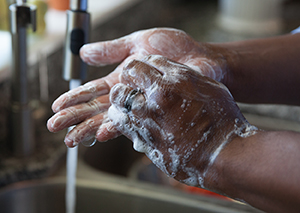Home Infusion Therapy: Preventing Infection
Infusion therapy is a safe way to take medicines or fluids that can’t be taken by mouth. A nurse will show you or your caregiver how to set up your home infusion system. Treatment will become part of your daily routine. To prevent infection, wash your hands before and after treatment. Also keep your setup area clean. And check the infusion site on your arm or chest daily for signs of infection.
What is infusion therapy?
With infusion therapy, medicines, nutrition, or fluids are given by IV (intravenously) into a vein. This is done using a soft plastic tube (catheter). Then your blood carries the treatment all over your body. Many types of catheters or ports can be used for home infusion. Some are in the arm, while others are on the chest. The type you have depends on what the treatment is and how long you'll need it.
Washing your hands

Tips for thorough handwashing before and after the infusion:
-
Stand in front of a sink and wet your hands with clean, running water.
-
Use an antiseptic liquid soap and lather all of both hands by rubbing them together well. Include the backs of your hands, between your fingers, and under your fingernails.
-
Scrub your hands between your fingers and under your fingernails for at least 20 seconds (about as long as humming the Happy Birthday song twice from beginning to end).
-
Rinse with clean, running water, keeping your fingers pointed down.
-
Use a paper towel to dry your hands and wrists and to turn off the faucet.
Setting up
Tips for setting up:
Caring for the infusion site
Tips for infusion site care:
-
Follow the nurse’s directions for cleaning your infusion site and flushing the catheter before and after treatment. Ask the nurse if you should use sterile gloves.
-
Check the site daily for signs of infection. These may be drainage, soreness, or redness at the catheter site. Also check your temperature if you think you have a fever. Report these signs to your healthcare provider.
-
Keep the infusion site dry. Ask the nurse how to bathe safely.
Online Medical Reviewer:
Marianne Fraser MSN RN
Online Medical Reviewer:
Rita Sather RN
Online Medical Reviewer:
Susan K. Dempsey-Walls RN
Date Last Reviewed:
11/1/2023
© 2000-2025 The StayWell Company, LLC. All rights reserved. This information is not intended as a substitute for professional medical care. Always follow your healthcare professional's instructions.